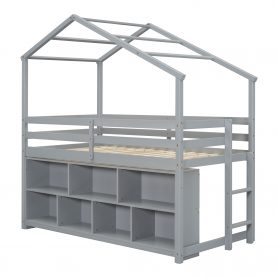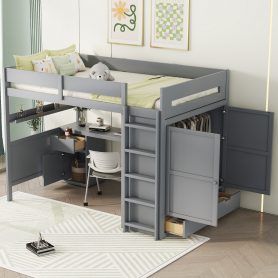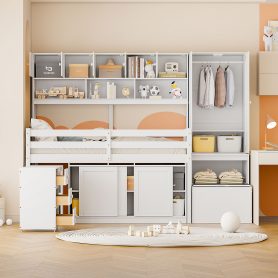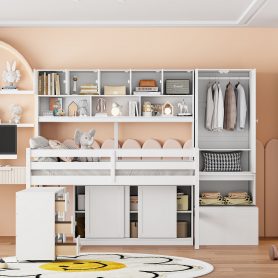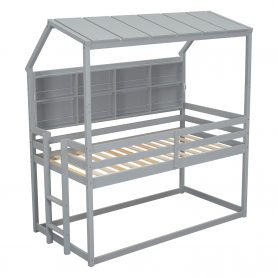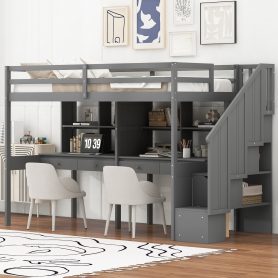
Introduction
Loft beds have become increasingly popular in recent years due to their space-saving design and versatility. However, when it comes to toddlers, safety is of utmost importance. Parents often wonder if loft beds are a suitable option for their little ones. In this article, we will explore the safety considerations of using loft beds for toddlers and provide valuable insights to help you make an informed decision.
Table of Contents
Why Consider Loft Beds for Toddlers?
Loft beds offer numerous benefits for toddlers and their families. Firstly, they maximize the use of vertical space, making them ideal for small bedrooms or shared rooms. By elevating the bed, loft beds create additional storage or play areas underneath, promoting a clutter-free environment. This can be especially advantageous for families seeking innovative solutions to optimize their living spaces.
Safety Considerations
While loft beds can be a practical choice, safety should always be the top priority when it comes to toddlers. Before deciding on a loft bed for your child, it is essential to consider the following factors:
- Age and Development: Toddlers should be at least three years old before using a loft bed. At this age, they have better motor skills and coordination, reducing the risk of falls.
- Sturdy Construction: Opt for loft beds made from durable materials such as solid wood or metal. Ensure that the bed frame, railing, and ladder are sturdy and securely fastened to prevent accidents.
- Guardrails: Loft beds should have properly installed guardrails on all sides of the elevated sleeping area. The guardrails should be at least five inches high to prevent accidental falls during sleep.
- Ladder Safety: Choose loft beds with stable and wide ladders, preferably with anti-slip treads. Teach your toddler how to use the ladder safely and supervise their initial attempts until they become comfortable.
By considering these safety measures, loft beds can be a safe and functional sleeping option for your toddler, providing them with both comfort and an exciting space to play and sleep.
What is a Loft Bed?
A loft bed is a type of bed that is raised off the ground, creating an open space underneath. It is designed to maximize space in a room, making it a popular choice for small bedrooms, dorm rooms, and apartments. Loft beds are typically supported by a sturdy frame and have a ladder or stairs for easy access to the elevated sleeping area.
Features of a Loft Bed
Loft beds come in various designs and configurations, but they generally share some common features:
- Elevated Sleeping Area: The main characteristic of a loft bed is its raised sleeping platform, which is typically positioned at least 5 feet off the ground. This elevated space provides ample room underneath for various purposes.
- Space-Saving Design: Loft beds are known for their space-saving design. By utilizing the vertical space in a room, they free up valuable floor space, which can be used for other furniture or activities.
- Underneath Space: The area underneath the loft bed can be utilized in different ways, depending on the design. Some loft beds feature a built-in desk, storage compartments, or seating area, while others offer an open space that can be customized to suit individual needs.
- Sturdy Construction: Loft beds are designed to be stable and secure. They are typically made from durable materials such as wood or metal and are engineered to support the weight of the mattress and the person sleeping on it.
- Ladder or Stairs: To access the elevated sleeping area, loft beds are equipped with a ladder or stairs. These provide a safe and convenient way to climb up and down the bed.
Benefits of a Loft Bed
There are several advantages to using a loft bed:
- Space Optimization: Loft beds are an excellent solution for maximizing space in small rooms. By raising the bed off the floor, they create additional usable space underneath.
- Multi-Functional: The area beneath a loft bed can be transformed into a functional space that meets various needs. It can be used as a study area, play zone, storage space, or even a cozy seating area.
- Cost-Effective: Loft beds are often more affordable than other types of beds, making them a budget-friendly option for individuals or families.
- Stimulates Imagination: Loft beds can spark creativity and imagination, especially for children. The space underneath can be transformed into a fort, a cave, or a secret hideaway, providing endless opportunities for imaginative play.
Overall, loft beds are a practical and versatile solution for maximizing space and creating functional areas in small rooms. With their sturdy construction and various design options, loft beds can be a safe and convenient sleeping arrangement for toddlers when appropriate safety measures are taken into consideration.
Benefits of Loft Beds for Toddlers
Loft beds are becoming increasingly popular for toddlers due to their numerous benefits. These elevated beds not only provide a cozy sleeping space for your little one, but they also offer several advantages that can enhance their overall development and well-being. Let’s explore some of the key benefits of loft beds for toddlers:
1. Maximizing Space
One of the primary advantages of loft beds for toddlers is their ability to maximize space in a child’s room. With their elevated design, loft beds free up valuable floor space, allowing for the incorporation of other essential furniture or play areas. This is especially beneficial in small bedrooms where every square foot counts. By utilizing vertical space, loft beds provide a practical solution for optimizing the available area.
2. Encouraging Independence
Having their own loft bed can help toddlers develop a sense of independence. Climbing up and down the ladder or stairs to their bed promotes physical coordination and motor skills. Additionally, being able to sleep in their own elevated space gives toddlers a feeling of ownership and autonomy, fostering their confidence and self-reliance.
3. Creating a Play Area
Loft beds offer the opportunity to create an additional play area underneath the bed. This space can be transformed into a cozy reading nook, a mini art studio, or even a pretend play zone. With the addition of curtains or canopies, the area beneath the loft bed becomes an enchanting hideaway for imaginative play. This not only encourages creativity but also helps in organizing toys and keeping the room tidy.
4. Transitioning to a Big Kid Bed
Transitioning from a crib to a big kid bed is a significant milestone for toddlers. Loft beds can facilitate this transition by providing a safe and secure sleeping environment. The raised design of the bed offers a comforting barrier that prevents accidental falls during the night. Additionally, loft beds often come with sturdy guardrails to further ensure the safety of your toddler, making the transition to a big kid bed smoother and less daunting for both parents and children.
In conclusion, loft beds for toddlers offer a range of benefits that go beyond just providing a place to sleep. By maximizing space, encouraging independence, creating a play area, and aiding in the transition to a big kid bed, loft beds can greatly enhance your toddler’s room and overall development.
Safety Considerations for Loft Beds
When it comes to choosing a loft bed for your toddler, safety should be your top priority. While loft beds offer many benefits, such as maximizing space in a small room, it is essential to ensure that the bed is constructed and used in a safe manner. Here are some important safety considerations to keep in mind:
1. Sturdy Construction
A sturdy construction is crucial for the safety of a loft bed. Ensure that the bed frame is made of high-quality materials, such as solid wood or metal, which can withstand the weight and movements of an active toddler. The bed should be properly reinforced and securely built to prevent any wobbling or collapsing.
2. Guardrails and Ladders
Guardrails are essential safety features that prevent your toddler from rolling off the bed during sleep. Make sure the loft bed you choose has guardrails on all sides, and the gaps between the guardrails are narrow enough to prevent your child from getting stuck. Additionally, check that the ladder is securely attached and provides a stable and safe way for your toddler to climb up and down.
3. Age Appropriateness
Consider the age and developmental stage of your toddler when choosing a loft bed. Some loft beds may not be suitable for very young children who are not yet capable of climbing up and down safely. Opt for a loft bed that is specifically designed for toddlers and has age-appropriate features to minimize the risk of accidents.
4. Height and Ceiling Clearance
Ensure that the loft bed has adequate height and ceiling clearance to prevent your toddler from hitting their head on the ceiling or any hanging objects. Measure the height of the room and the space between the bed and the ceiling to ensure a safe distance. Also, make sure there are no ceiling fans or light fixtures directly above the bed that could pose a risk.
5. Regular Inspections
Regularly inspect the loft bed for any signs of wear and tear, loose screws, or damaged parts. Check the stability of the bed and ensure that all the joints and connections are secure. Regular maintenance and inspections will help identify any potential hazards and allow you to address them promptly.
By considering these safety factors, you can ensure that your toddler’s loft bed provides a secure and comfortable sleeping environment. Remember to always prioritize safety and supervise your child while using the loft bed to minimize any potential risks.
Tips for Ensuring Loft Bed Safety
When it comes to loft beds for toddlers, safety should always be the top priority. Here are some essential tips to follow to ensure the safety of your child:
1. Choose the Right Bed
Start by selecting a loft bed that is specifically designed for toddlers. Look for beds with low height and sturdy construction. Make sure the bed has guardrails on all sides to prevent your child from falling off. Avoid beds with sharp edges or protruding parts that can pose a risk of injury.
2. Follow Manufacturer’s Instructions
Always read and follow the manufacturer’s instructions carefully when assembling the loft bed. Each bed may have specific guidelines and recommendations for installation, weight limits, and safety precautions. Following these instructions will ensure that the bed is assembled correctly and securely.
3. Secure the Bed Properly
Once the loft bed is assembled, ensure that it is securely anchored to the wall or floor. This will prevent any accidental tipping or wobbling of the bed. Use sturdy brackets or straps to secure the bed to the wall or floor, as recommended by the manufacturer.
4. Educate Your Child on Safety Rules
Teach your child about the importance of safety when using the loft bed. Explain the rules such as not jumping on the bed, using the ladder properly, and not playing near the edges. Emphasize that the loft bed is for sleeping and not for rough play. Encourage your child to always use the guardrails and to be mindful of their movements while on the bed.
5. Regularly Check for Hazards
Regularly inspect the loft bed for any potential hazards. Check for loose screws, broken parts, or any signs of wear and tear. Ensure that the guardrails are securely in place and that there are no gaps that a child’s body could slip through. If you notice any issues, promptly repair or replace the bed to maintain its safety.
By following these tips, you can ensure that your toddler’s loft bed provides a safe and secure sleeping environment. Remember, it is crucial to prioritize your child’s safety at all times.
Conclusion
In conclusion, when it comes to the safety of loft beds for toddlers, it is important to prioritize their well-being and take necessary precautions. While loft beds can be a practical and space-saving solution, parents need to consider various factors before making a decision.
1. Age Appropriateness: Toddlers are typically not ready for loft beds due to the potential risks involved. It is recommended to wait until they are older and more capable of safely using a loft bed.
2. Safety Measures: If you decide to introduce a loft bed for your toddler, ensure it meets safety standards. Look for sturdy construction, guardrails on all sides, and secure ladders or stairs. Regularly inspect the bed for any loose or broken parts.
3. Supervision: Always supervise your toddler when they are using the loft bed. Teach them how to safely climb up and down the ladder or stairs and instruct them on proper bed usage to minimize accidents.
4. Room Layout: Consider the layout of the room and ensure there is enough space around the loft bed to prevent any potential falls or injuries. Keep the area underneath the loft bed clear of any hazards.
5. Alternative Options: If you are concerned about the safety of loft beds for toddlers, there are alternative sleeping arrangements such as low bunk beds or floor beds that can provide a safer sleeping environment for young children.
Remember, the safety and well-being of your toddler should always be the top priority. Consult with a professional if you have any doubts or concerns about introducing a loft bed into your toddler’s room.
By carefully considering the age appropriateness, implementing safety measures, providing supervision, considering room layout, and exploring alternative options, you can make an informed decision about whether a loft bed is suitable for your toddler.
-
 Twin House Loft Bed with Roof Frame, Under Bed Shelving Storage Unit, Guardrails, Ladder$348.06
Twin House Loft Bed with Roof Frame, Under Bed Shelving Storage Unit, Guardrails, Ladder$348.06 -
 Full Size Wooden Loft Bed With Wardrobe, Desk, Drawers, and Shelves$723.25
Full Size Wooden Loft Bed With Wardrobe, Desk, Drawers, and Shelves$723.25 -
 Twin Size Wooden Loft Bed Big Storage With Under-Bed Desk, Drawers and Shelves$904.57
Twin Size Wooden Loft Bed Big Storage With Under-Bed Desk, Drawers and Shelves$904.57 -
 Full Size Wooden Loft Bed Big Storage With Under-Bed Desk, Drawers and Shelves$940.20
Full Size Wooden Loft Bed Big Storage With Under-Bed Desk, Drawers and Shelves$940.20 -
 Twin House Loft Bed with Guardrails, Semi-enclosed Roof, Bedside Shelves and Ladder$334.31
Twin House Loft Bed with Guardrails, Semi-enclosed Roof, Bedside Shelves and Ladder$334.31 -
 Twin Size Loft Bed Frame with Storage Staircase and Double Desks and Shelves$606.41
Twin Size Loft Bed Frame with Storage Staircase and Double Desks and Shelves$606.41

